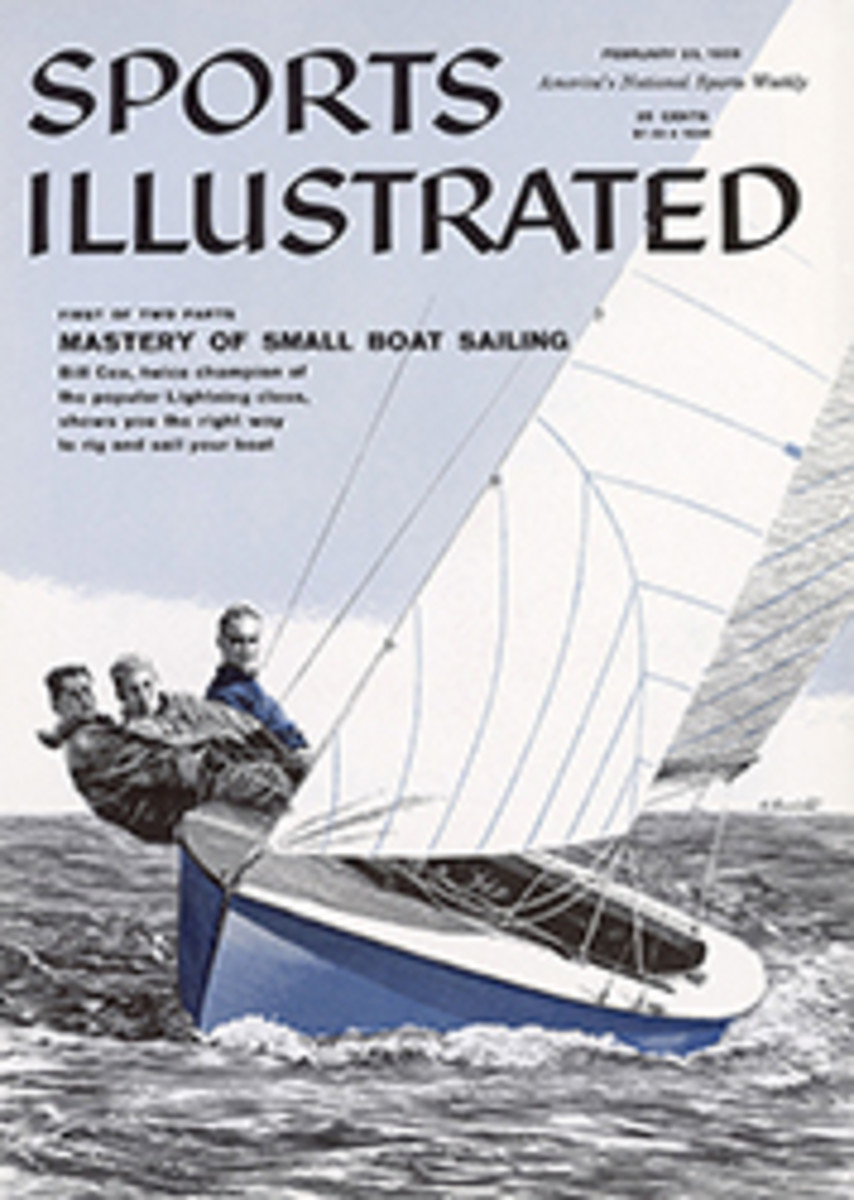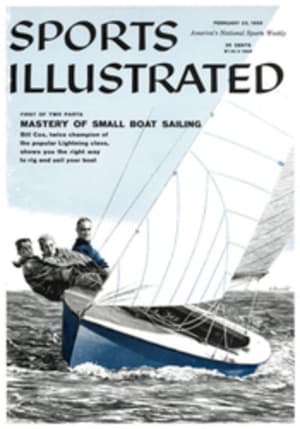
TRIAL AND TRIUMPH
St. Moritz is a Miami-in-the-snow, with millionaire magnates moving into hotels with large retinues and Elsa Maxwell due at any moment. Attractive ladies in tight stretch pants preen themselves in hotel bars and salons at all hours, Dr. Gut's clinic is enjoying its seasonal spurt of shaping wet plaster around limbs of daily ski casualties, and Shipowner Stavros Niarchos uses a helicopter to take him to remote peaks or to a glorious new ski run without having to wait in line for a ride in the téléférique.
In this heady mountain air last week bobsledders from 10 nations congregated for their annual world championship. They, too, had a democratic spread, from a Spanish marquis and an English lord to a lumber salesman, several U.S. marines and two cops from Saranac Lake, N.Y. They had a common purpose, however, and it was a simple one: to shoe as quickly as possible down a precipitous, convoluted one-mile stretch of ice outside the town.
For them, everything else in gay St. Moritz was secondary. But to be on the safe side, some teams brought their wives and others were closely chaperoned by managers alert for any signs of backsliding.
The start of the icy run is on a hill at the edge of St. Moritz, and its finish is down the Engadine Valley, at the edge of another town: Celerina. In between there is a drop of 395 feet and 16 curves of varying challenge and colorful nomenclature: Snake, Horse Shoe, Shamrock, Dyke, Bridge and The Leap. Each curve has its feminine eccentricities and moods which change as morning temperatures rise and the ice melts slightly. Drivers who do best whipping down the course at speeds approaching 80 mph are those who compromise with these ladies rather than fight them.
Hard work and experienced teamwork paid off in the two-man bobsled world championships, which were held first. After the first day's runs the leading Italian duo of Sergio Zardini and Luciano Alberti were ahead (by 8/100 of a second) of the Americans, Physicist Arthur Tyler and Marine Lieutenant Tom Butler. In third place, one and a half seconds off the lead, was the defending champion, Italy's Eugenio Monti, and an old teammate, Renzo Alvera. The Americans were riding a sled of Tyler's own design, which was having trouble getting off to fast starts in that brief period before jumping in. On the final runs next day Zardini turned in a damaging time when his sled bumped and slowed on the wall en route. Then old pro Monti broke up the ball game with a new course record of 1:20.26. The order at the finish of the two-man bobsled championships: Monti, Zardini and Tyler.
Monti at 165 and Zardini at 132 pounds typify bobsledding's trend toward smaller and more active men. Until 1952 the sled weight was standardized but crew members could weigh as much as they could eat. As a result the heaviest teams usually got to the bottom fastest, for it's accepted knowledge that a fat man will slip faster over an irregular downhill course than a small boy. But the days when burly bobsledders floated like icebergs down the mink-lined streets of St. Moritz ended with the 1952 Olympics, when the German team, which won the four-man title, was found to weigh a total of 1,050 pounds—close to 260 per man. Rules were quickly changed to discourage monstrosities from taking to the ice, and the total team weight on the hoof now cannot be more than 882 pounds. Teams weighing less are entitled to add the weight difference to sleds in the form of lead which, being lower to the sled's center of gravity, is considered more helpful by some than big paunches and haunches in gaining acceleration rapidly. Smaller men are also better at starting sleds.
When the two-man bobsleds were put away, the big four-man sleds were brought out for Martineau Cup competition, a two-morning meet designed to reduce teams to two per nation for the four-man world championships which were to follow. The U.S. had four entries: Tyler's, an Air Force team driven by Major Jerry O'Toole, one assembled by veteran Dick Severino, and the Lake Placid crew of Stanley Benham. Art Tyler went in with a good record as bridesmaid, having taken third in the 1956 Olympic's four-man and third in the 1957 world championship.
The German team driven by Franz Schelle, who placed second to teammate Hans Roesch in last year's world championship, had not competed in the two-man events, but now he raced away as though-he'd been practicing on the Moritz run since the middle of January. Tyler set the lowest single time of the meet with 1:18.37, but his crew was still having trouble getting started quickly, and Schelle's consistent low times won him the Martineau Cup by a full half second over Italy's wispy Zardini. Close behind was Tyler's crew, with fourth and fifth places going to Switzerland's Zoller and United States' Benham.
The day of the first two heats of the world championships dawned clear, crisp—and tense. The bobsledders gathered, tinkered with their sleds at starting point, worried how best to save vital hundredths of seconds on each tricky curve. Stylish crowds gathered at vantage points. Reporters and photographers converged from all over Europe to clot the start and finish. Meanwhile, Tyler's crew had been working on their starting technique. They had spent a previous afternoon scattering nursemaids and children on a snowy lane near the bob run while they practiced starts.
Now the championships officially began as, with a whoop and a holler, Tyler and Co. shoved off furiously, pounding down those 10 to 15 initial yards before jumping on the sled and disappearing around the first bend. It was not a particularly fast start, but Tyler's sled and driving usually combine to pick up more speed downhill than his rivals.
At the finish one mile away Tyler's crew braked to a stop in a cloud of flying ice, then waited impatiently for the loudspeaker to announce the time. It came, 1:17.90—Tyler had cracked the 1:18 barrier.
Italy's little Zardini shot down next after a fast start and shaved two-hundredths of a second from Tyler's time. The German wonder boy, Schelfe, surprised no one by recording the fastest time of the opening heat—1:17.63. In the second heat (the championship would go to the lowest aggregate time over four runs) Schelle slid down in a sparkling 1:17.70. "My men are too light and my sled too heavy," Art Tyler muttered gloomily when he saw Schelle's time. Schelle seemed unbeatable. Yet Tyler's crew was all business when it moved to the start for the second and last heat of the day. "Get your hardware on," Tyler said, and his men donned their helmets. No. 2 man Gary Sheffield, a good Catholic, crossed himself while Brakeman Butler fussed with the sled's rear runners. Butler counted to three, they all strained, and ran, and they were off. Just 1:17.42 later, Tyler's crew was at the finish with a course record for the St. Moritz bob run. Tyler's margin over Schelle midway through the competition was one one-hundredth of a second.
Shortly before their first run on the final day, Tyler's crew seemed to have encountered disaster. While the sled was on its side to allow the runners to be cleaned, one of the two vertical push bars at the rear snapped off at the base. These bars not only help the crew to push off to a fast start—they are needed by the brake-man, the last man to jump onto the sled at the beginning of the run. There was no time for repairs and it seemed like a crushing blow.
The American outlook brightened, though, when Franz Schelle (it had been rumored that he would tighten up under pressure) turned in a poor time of 1:18.51 for the first run.
No one went under 1:18 until Italy's Zardini came through with a sharp 1:17.74. Tyler's sled, minus one push bar, was next, and Brake-man Tom Butler wondered how he would board that speeding sled at the start.
Somehow he did, and the team turned in a brilliant 1:17.73 that narrowed the championship to a duel between Tyler and Zardini.
Zardini went down for the last time in a fine 1:17.94. Tyler was to follow, and suspense was keen at the starting point—the question being not so much whether Tyler could beat Zardini's time again, but whether he would arrive at the bottom with his brakeman aboard.
Butler reassured his wife, "You know darn well that if that sled's going down the mountain I'm going with it," but with his teammates he was less confident: "I had to hustle to get aboard on that last run, I don't know if I can make it this time."
Tyler's crew grimly went ahead with their count-off, then shoved away. At the last possible second Butler threw himself after the sled, landing there on his knees with a crack. He was seen still struggling to assume a sitting position when the sled disappeared around the first turn.
Someone shouted excitedly that Butler had fallen off. No one was sure. The loudspeaker announced the sled's interim times as if nothing had happened.
Nothing had—except that when Tyler arrived at the bottom with a full complement of crew, his time was again better than Zardini's—1:17.77. American cheers rang forth at both ends of the run. Arthur Tyler's homemade sled, with a total time of 5:10.82 for the four runs, had brought the U.S. its first four-man world bobsled championship in six years.
PHOTO
JOHN SADOVY
HURTLING around Horse Shoe Curve, a sled climbs the glare ice wall toward spectators as it careens by at 65 mph.
PHOTO
JOHN SADOVY
CHIEF architect of U.S. victory, Driver Tyler designed winning sled himself.
PHOTO
JOHN SADOVY
YOUNGEST on U.S. sled, Gary Sheffield, 22, is a marine from Lake Placid, N.Y.
PHOTO
JOHN SADOVY
BIGGEST man of lightweight Tyler crew, Parker Vooris weighed in at 215 pounds.
PHOTO
JOHN SADOVY
TOUGHEST man on the sled, Tom Butler handled rugged job of applying brakes.
PHOTO
JOHN SADOVY
RUNNER-UP IN WORLD CHAMPIONSHIPS, ITALY'S NO. 2 SLED, DRIVEN BY SERGIO ZARDINI, BUZZES THROUGH A HIGH-SPEED CORNER DURING THE MILE-LONG RUN
PHOTO
JOHN SADOVY
TWO-MAN WINNER, Eugenio Monti of Italy (right, above), smilingly accepts congratulations from a cluster of admirers. This was his third successive two-man title.
PHOTO
JOHN SADOVY
FOUR-MAN WINNER, Art Tyler (at wheel), steadies sled as brakes throw roostertail of snow at end of run while No. 3 man Vooris holds injured leg out of harm's way.
PHOTO
JOHN SADOVY
GAME LOSER, Spanish driver Vicente Sartorius, who inherited sled from cousin Marquis de Portago after latter's death, drove to commemorate Portago's bold spirit.

